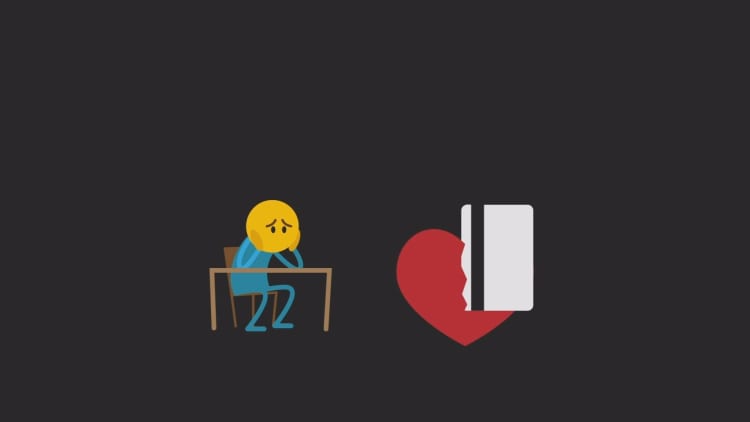The amount of money that U.S. consumers shell out yearly in credit cards fees and interest has passed the $100 billion mark, new research shows.
With credit card debt at more than $1 trillion and interest rates ticking upward, consumers paid nearly $104 billion in those charges during the 12 months that ended March 31, according to data from Magnify Money.
That figure is 11 percent more than the $93.7 billion tallied a year earlier and 39 percent more than the $74.6 recorded in 2013.
The company also forecasts that when it takes its yearly measurement after next March 31, the total paid in fees and interest during the preceding 12 months could be more than $110 billion.
That projection factors in four quarter-point increases in a key interest rate set by the Federal Reserve. While it's uncertain exactly what the Fed will do and when, one thing is for sure: Whenever that rate does go up, credit cards typically will follow suit within a day or two.
Already, the Federal Reserve has boosted rates twice this year by a quarter-point each time. That’s on the heels of three quarter-point increases last year and one in each 2015 and 2016. At its most recent meeting, Fed policymakers indicated that two more bumps are likely on the way this year, with gradual increases continuing into 2019.
The rising cost of credit card debt*
| 2013 | $74.6 billion |
| 2014 | $76.5 billion |
| 2015 | $78.6 billion |
| 2016 | $84.9 billion |
| 2017 | $93.7 billion |
| 2018 | $103.7 billion |
Source: Source: MagnifyMoney.com *Credit card fees and interest earned by U.S. banks, year ending March 31
While the current 2 percent is low from a historical standpoint, credit card interest rates run much higher than that federal rate.
The average interest rate on credit cards is close to 17 percent, although some can run much higher, depending on the type of card itself (i.e., a retail store card) and your credit score.
If you are among those consumers buried in plastic debt and are unsure how to dig yourself out, start by getting organized.
“You need to come up with a plan to get out of debt,” said Nick Clements, co-founder of Magnify Money. “It needs to be concrete and it needs to have an end date.”

There’s also another issue you might need to address: the psychological one.
“You have to deal with the reasons why you ended up in debt anyway,” Clements said. “If it’s because of a [spending] mindset, that needs to change.”
Here are some ways to pay down credit card debt.
Balance transfer options
If your credit score is high enough to qualify for a zero-interest or low-interest balance-transfer offer, consider taking it.
While these deals typically come with a balance-transfer fee, the introductory rate can last anywhere from a few months or a year or more. At the end of the deal, the remaining balance begins accruing interest at the then-current rate.
If you’re the type who will charge up to the limit on every credit card, a zero-percent transfer probably isn’t going to change that.Nick Clementso-founder of Magnify MoneyC
Not only do you avoid paying high interest on the debt, you can potentially pay it down more quickly because all (or most) of your payment will go toward the balance instead of interest.
However, going this route involves some self-discipline: You can’t use any available credit on the new and old cards or you’ll only dig yourself deeper into debt.
“If you’re the type who will charge up to the limit on every credit card, a zero-percent transfer probably isn’t going to change that,” Clements said. “If you’re highly disciplined, though, it can be a great way to manage your debt.”
Personal loans
Depending on your credit score, you might be able to consolidate your credit card debt into a personal loan and pay a lower interest rate by doing so.
Rates on these loans varies widely, ranging from about 4 percent to as much as 36 percent. The better your credit score, the better rate you’ll get. The amount you are borrowing, along with the length of the loan, also will affect the interest rate.
More from Personal Finance:
Most Americans would give up social media to erase credit card debt
The best and worst ways to borrow money
How you can save upward of $2,000 annually while improving your health
Remember that if the personal loan is part of your plan to get out of debt, you’ll need to destroy the paid-off card. Again, if you simply charge more on it, you’ll end up in a worse financial position.
Additionally, there is no flexibility in repaying the loan.
“The payment is the payment,” Clements said. “So you have to know you’ll be able to consistently afford the terms of the loan.”
Strategize your repayment efforts
There are a couple of approaches that experts recommend to pay off credit card debt.
The first approach involves funneling most of your repayments toward the card with the highest interest rate. In other words, you pay the minimum on the lower-rate cards and put any extra you possibly can toward the debt that's costing you the most in interest.
Once the most expensive debt is paid off, you move on to the card with the next-highest rate.
The other strategy is to work toward paying off the lowest balances first, which can help give you a sense of accomplishment and momentum to continue tackling your debt. However, you might end up paying more in interest if you take this route.


